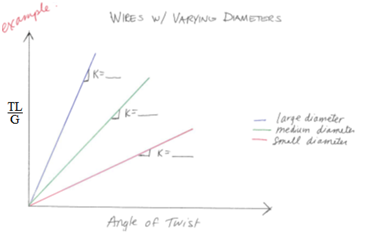Reference no: EM131011986
The objective of this experiment was the find the relationship between the applied torque and angle of twist for a metal wire of various (lengths, diameters, and/or materials); and compare and contrast with each other. This was accomplished by ... ... The findings were ... ... Based on the findings, the author concluded that ...
The testing program for this experiment is summarized in Table 1
Table 1. Testing Program
|
Test ID
|
Wire Diameter (cm)
|
Wire Material
|
Wire Length (cm)
|
|
Run #1
|
0.19
|
Steel
|
30.6
|
|
Run #2
|
0.19
|
Steel
|
15.5
|
|
Run #3
|
0.10
|
Steel
|
30.6
|
|
Run #4
|
0.10
|
Steel
|
15.5
|
|
Run #5
|
0.14
|
Brass
|
30.6
|
|
Run #6
|
0.14
|
Brass
|
15.6
|
The influence of Diameter, Length and Modulus on Rotational Stiffness is shown in Figures 1 through 3, respectively.

Figure 1. Influence of Diameter on Rotational Stiffness (TL/G versus Angle of Twist)
Insert Figure 2 here
Figure 2. Influence of Length on Rotational Stiffness (T/JG versus Angle of Twist)
Insert Figure 3 here
Figure 3. Influence of Shear Modulus on Rotational Stiffness (TL/J versus Angle of Twist)
This example does not directly apply to what you tested. The takeaway from this example is:
1. Use linetype or color to help visually distinguish data
2. Label slope values, "k = ..."
3. Don't forget to normalize!
Table 2 summarizes the above results.
Table 2. Summary of Results
|
Run
|
Dia., D
|
Length, L
|
Material
|
Expected Shear Modulus, G†
|
Rotational Stiffness, K
|
% diff*
|
|
measured
|
expected
|
|
1
|
|
|
|
|
|
|
|
|
2
|
|
|
|
|
|
|
|
|
3
|
|
|
|
|
|
|
|
|
4
|
|
|
|
|
|
|
|
|
5
|
|
|
|
|
|
|
|
|
6
|
|
|
|
|
|
|
|
† cite source
* % diff = (measured - expected)/expected
1. Why did you normalize the above graphs? What is the significance of the resulting slopes?
2. Define "rotational stiffness" in terms of a member's geometric and material properties.
3. How do the experimental measurements compare with expected values? Explain the cause/significance of the similarities/differences - be specific and do not blame "human error".
4. Explain how modulus of rigidity, G, is analogous to modulus of elasticity, E.
The original objective of this experiment was to find the relationship between the applied torque and angle of twist for a metal wire of various (lengths, diameters, and/or materials); and compare and contrast with each other. Based on the above results, the author determined that ...
Attachment:- Assignment.rar
|
Propose for the statistical analysis
: What course of action would you propose for the statistical analysis if it was learned that Vietnam veteran #646 (the largest observation in Display 3.6) worked for several years, after Vietnam, handling herbicides with dioxin? (b) What would you ..
|
|
Problem regarding the cloud seeding
: 1. Cloud Seeding. What is the experimental unit in the cloud seeding experiment? 2. Cloud Seeding. Randomization in the cloud seeding experiment was crucial in assessing the effect of cloud seeding on rainfall. Why?
|
|
Fish oil and blood pressure
: Repeat Exercise 19 for the group of men who were given the fish oil diet and then answer these questions: Is there any evidence that the mean reduction for this group is different from zero? What is the typical reduction in blood pressure expected..
|
|
The grants finch complete beak data
: The data file ex0218 contains the beak depths (in mm) of all 751 finches captured by Peter and Rosemary Grant in 1976 and all 89 finches captured in 1978 (as described in Section 2.1.1). Use a statistical computer program for parts a-d:
|
|
Define rotational stiffness in terms of a member''s geometric
: Why did you normalize the above graphs? What is the significance of the resulting slopes? Define "rotational stiffness" in terms of a member's geometric and material properties
|
|
Motivation and creativity
: Verify the statements made in the summary of statistical findings for the Motivation and Creativity Data (Section 1.1.1) by analyzing the data on the computer.
|
|
Cation in aqueous acid solution
: Why is the word aquation used in the title of this experiment?The aquation of the tris-(1,10-phenanthroline) iron(11) Cation in aqueous acid solution
|
|
Fish oil and blood pressure
: Find the 95% confidence interval and one-sided p-value asked for in Exercise 13(e) and (g) but use a statistical computer package to do so.
|
|
What radius and height do you recommend for cylindrical tank
: The customer also wants to use the smallest amount of material possible in building the tank. What radius and height do you recommend for the cylindrical portion of the tank? Use Lagrange multipliers.
|